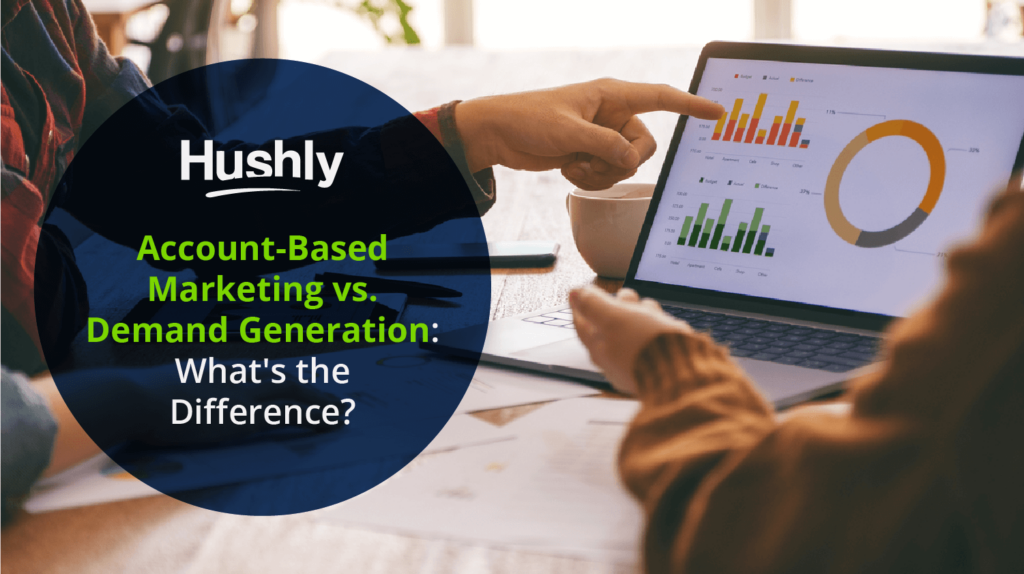Account-based marketing (ABM) is an old idea that continues to generate buzz and influence B2B sales around the world. Demand generation is a similarly well-understood set of strategies companies use to improve the quality of their sales leads, if not the quantity of them.
Of the countless marketing strategies available for modern businesses, these are two of the most useful concepts to understand and utilize. Each contains something that nearly every business or industry should be able to take and make use of for their own marketing operations.
We’ve crafted today’s blog to help explain the main differences between account-based marketing and demand generation, the importance of both, and why you should likely be using a combination of them for your marketing strategies.

What is Account-Based Marketing?
ABM is a proven marketing strategy developed in the mid-1990s through the mid-2000s, which focuses on creating unique marketing content for individual buyers. ABM can be seen as a form of corporate whale-hunting where your company pulls out all the stops in a coordinated effort to land a huge client.
The idea behind ABM is that obtaining the highest-value B2B customer possible is preferable to, or at least as valuable as, casting a wide net and attracting many smaller customers instead.
Why Account-Based Marketing Works
ABM strategies use direct communication with targeted buyers. A combination of personalized marketing content, communication, engagement, and service is meant to let the buyer know they will be an important and valuable client for the business doing the marketing.
Similar to other consumer-oriented solutions like a user-friendly online ordering portal, account-based marketing is quickly becoming the norm in large B2B relationships.
ABM strategies can make it easier to identify real leads in a sea of noisy data. For example, Hushly helped NVIDIA accomplish a better lead conversion rate and lead conversion time by creating personalized experiences for targeted companies.
Account-based marketing represents more than 70% of marketing budgets, meaning B2B sellers and buyers are both aware of the importance and effectiveness of this strategy.
ABM Represents Commitment to Your Largest B2B Clients
ABM works best when part of a holistic, consumer-oriented business cycle known as account-based experience (ABX). However, ABM strategies will work just fine on their own even if not paired with a larger shift in operations.
Whether or not you commit to a more comprehensive ABX strategy or stick with the basic ABM techniques, your ABM operations should be seen as a process that emphasizes the importance of your largest B2B clients.
What is Demand Generation?
There are two main ways to generate conversion opportunities: increase the number of leads or increase their quality.
A quality lead may still not turn into a sale if the demand for your product isn’t high enough. Here is where demand generation comes in.
Lead Generation vs. Demand Generation
It’s important to realize that generating demand is not the same thing as generating a lead. If you promise that your product helps with a certain problem, you may generate a lead when someone hears about it and wants to know more. However, if your product, or the way it’s advertised, isn’t up to par, the demand won’t exist, and you may not have a chance at converting.
How to Make Customers Want Your Product
Demand generation aims to improve the likelihood that someone will buy your product by increasing demand for it. This can be done in many ways. For example, a product that recently underwent a huge improvement or update may be subject to increased demand.
Similarly, you can convince a customer that your product is in demand by presenting it to them in the most effective way possible. This includes not just things like the marketing copy but also how you reach out to the customer, how often you follow up with them, and the specific products or services you choose to offer them.
As an example, Hushly helped our cybersecurity client Check Point increase form completion rates by 60% by choosing to give some of the product’s value for nothing in return, naturally generating increased demand and leads for paid products.
Demand Generation is Based on Quality, Not Quantity
Focusing on demand generation may not generate the largest number of leads. However, increasing demand is a natural way to increase lead quality. The more adept you are at marketing your product, the more likely someone will want to buy it.
Generating Demand is an Ongoing Process
A great demand-generating strategy doesn’t end when the sale is converted. In fact, it uses information gained from the sale and the marketing process to continually improve itself. A robust demand generation plan should be focused on long-term growth and client relationships in addition to increasing demand from customers you haven’t converted yet.
How to Decide on Account-Based Marketing vs. Demand Generation
First, a quick recap of each strategy’s merits and drawbacks.
ABM Takes More Time But Offers Bigger Rewards
Account-based marketing will target the largest accounts in your industry, meaning that any given conversion could represent a huge change in your company’s future.
A good ABM strategy takes time to develop and expertise to craft well. It also requires timing and instinct to execute. It’s challenging to get right but doesn’t require lots of resources or effort to try.
It can also represent a valuable shift in the way your company approaches your best customers, shifting from a mindset of gathering as many clients as possible to nurturing and assisting the ones you already have.
Demand Generation is Simpler But Can Bring Mixed Results
Generating demand is not always easy or actually possible, depending on the product you’re selling or the conditions of the market. However, sometimes, it can be as simple as putting your product in front of the right reviewer or company that will spread the word for you.
Ultimately, demand generation can be an effective way to increase conversions or improve the leads you already have, but it largely rests on the quality of your product and the level of service you offer outside of your marketing team.
A Mix of Both Is Probably Right for Your Business
Marketing strategies are often treated as all-or-nothing propositions when the reality is far more fluid and unpredictable than this mindset would allow for. Luckily, ABM and demand generation can easily coexist within your company’s marketing operations.
Some basic demand generation should be practiced by every company since if no one wants to buy your product, you won’t have a business. Likewise, a level of account-based marketing is becoming irreplaceable for most modern B2B enterprises.
Customers, whether they are B2B buyers or everyday B2C consumers, expect a level of personalization and engagement that non-ABM tactics often don’t get right. This only applies even more strongly to the largest companies in their industries, which may be seen as whales desirable to any smaller company with a B2B product to offer.
As big targets who are frequently courted, they are used to all generic marketing and will need to be swayed by a more impressive, in-depth sales pitch inspired by ABM techniques.
A mixture of high-quality demand generation and account-based marketing is the key to landing these whales and keeping your smaller clients happy and demanding more from you at the same time.
Get a personalized demo to see how the Hushly platform can help your demand generation and account-based marketing operations.

